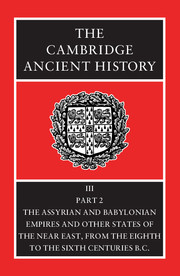
-
Select format
-
- Publisher:
- Cambridge University Press
- Publication date:
- March 2008
- January 1992
- ISBN:
- 9781139054294
- 9780521227179
- Dimensions:
- (231 x 158 mm)
- Weight & Pages:
- 1.66kg, 962 Pages
- Dimensions:
- Weight & Pages:
- Subjects:
- Ancient History, Classical Studies
- Collection:
- Cambridge Histories - Ancient History & Classics
- Series:
- The Cambridge Ancient History
You may already have access via personal or institutional login- Subjects:
- Ancient History, Classical Studies
- Collection:
- Cambridge Histories - Ancient History & Classics
- Series:
- The Cambridge Ancient History
Book description
Volume III Part II carries on the history of the Near East from the close of Volume III Part I and covers roughly the same chronological period as Volume III Part III. During this period the dominant powers in the East were Assyria and then Babylonia. Each established an extensive empire which was based on Mesopotamia, and each in turn fell largely through internal strife. Assyrian might was reflected in the imposing palaces, libraries and sculptures of the Assyrian kings. Babylonian culture was outstanding in literature, mathematics and astronomy, and the great buildings of Nebuchadnezzar II surpassed even those of the Assyrian kings. Israel and Judah suffered at the hands of both imperial powers, Jerusalem being destroyed and part of the population deported to Babylon; and Egypt was weakened by an Assyrian invasion. The Phoenicians found a new outlet in colonising and founded Carthage. A number of small, vigorous kingdoms developed in Asia Minor, while from the north and north east the Scythian nomadic tribes pressed down upon Turkey and the Danube valley, but found their match in the Thracian tribes which held south-eastern Europe and parts of western Turkey. The burials of the chieftains of both peoples were remarkable for the great wealth of offerings.
Reviews
"The answer to the question whether the ancient world is worth studying is 'yes', and the Cambridge Ancient History proves it....CAH III/2 is an impressive achievement." John Ray, Times Literary Supplement
Contents
Metrics
Altmetric attention score
Full text views
Full text views help Loading metrics...
Loading metrics...
* Views captured on Cambridge Core between #date#. This data will be updated every 24 hours.
Usage data cannot currently be displayed.
Accessibility standard: Unknown
Why this information is here
This section outlines the accessibility features of this content - including support for screen readers, full keyboard navigation and high-contrast display options. This may not be relevant for you.
Accessibility Information
Accessibility compliance for the PDF of this book is currently unknown and may be updated in the future.


